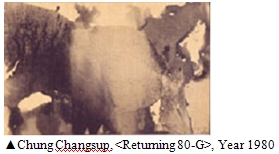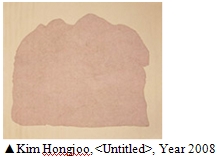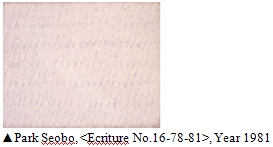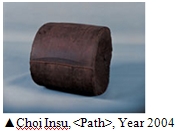Techniques of Abstraction
Then, what skills have been used for abstraction? The art of the 20th century took what the previous art did not significantly deal with as its core. It started to perceive the process of‘appreciation’or‘reception’as the fundamental ingredient of artistic production. The clue was given by Marcel Duchamp. Abstraction selectively depicts the particular modes of the world through the methods of simplification and abstraction. Like compressed digital information, a simplified object regains its original complexity as it is decompressed after it was delivered to the viewer. What is needed here is the mode of simplification so that the object can be compressed and decompressed properly. In the case of art, the process of simplification needs the condition that the complexity of society, cultural contexts and knowledge are required not only of the artist but also of the viewer. The processes of encoding and decoding cannot be carried out accurately in the field of art unlike in that of digital technology. The potential fallacy can even be encompassed by its potential capacity.
This section shows those works that well exemplify the techniques of abstraction. The artworks shown here including Duchamp’s Boîte à valise and Ahn Kyu-cheol’s The Man’s Bag invite the viewer to participate actively in interpreting their abstractness. The process of appreciation provides not only aesthetic pleasure but emotional adventure and delight as well.

Kho Nakbeom (1960- ) says that the portraits in his paintings signify a vertical image, and color bands signify a horizontal image. In the world of this absolute plane composed of an X-axis and a Y-axis, he adds the oblique line of a Z-axis as another dimension to create a multi-dimensional context. Here, the oblique line signifies an evolution of existing planar areas due to an interaction of totally new meanings. From the motif of a pentagon, he discovers a conceptual oblique line which leads to a new dimension. Often-mentioned morning glory flowers are also related to the pentagonal dimension. The <Countable Countless> series represent the world of this pentagon as a basic unit. This artist first designs limitlessly-expanding planes using this pentagon as a basic unit, and creates a disorderly-orderly but very intricate structure, by using a method of connecting color points which look like beads. This painting reminds viewers of an expanding galaxy. It appears to be inspired by the composition principle of nature, which consists of "order within disorder".
Countless color points evoke visual kinetics, as is the case with optical art, or cause intentional glare, as with the shapes on an eyesight test chart. As in his other works of art, each color point in this painting stems from a spectrum which symbolizes the dissimilar conditions and states of this world. When looking from a different angle, these color points, which are depicted realistically, also look like a surface composed of giant color threads. That is, the canvas has kept countless lines of numerous colors, the flow of time, and movement along the Z-axis static by instantly slicing them into a plane. These static color points can be counted, but their continuity, which continues in time, cannot be counted. Paintings express visible and invisible things at the same time. Kho Nakbeom 's several monochrome figure paintings will help the viewer to understand this world, which consists of these color particles. Colors are elements of abstractness and are also materials that compose this world.

Chung Changsup (1927- ) has been creating works of art which embody a key concept of Eastern philosophy, namely "The self and the universe are one", since the 1970s. <Returning 80-G> (1980) received an invitation artist award at the 29th National Art Exhibition of Korea (1980), and is one of the <Returning> series produced between the early 1980s and the mid 1980s. He covered the entire canvas with traditional Korean paper, hanji, and composed the screen by making fast and wide strokes with an ink brush after partitioning the screen into a number of units. Through this process, he tried to express Korean-style minimalism, which explores a new relationship between traditional Korean black ink (muk) and paper, and planes.
Paper is a basic foundation of Oriental painting. Two structural elements--surface and depth--differentiate paper from the canvas of an oil painting. Western oil painting or drawing methods focus on surfaces, whereas the use of paper in Oriental painting requires understanding and experience of the structure of materials, as paper plays an important role in determining time and concentration in the process of absorbing colors. Thus, a screen, which consists of paper, works as a support for painting, and as a multi-dimensional object with a structure. <Returning> is a work of art that clearly shows such differences. Painting gestures are recorded within the structure of a painting’s surface as the result of their fast interaction with the painting's surface. They might look like phantoms, but in actuality, they remain on the painting’s surface as a residue of physical and multi-dimensional incidents. Abstractness stems from resoluteness and cold objectivity. As can be seen in the series titled <Mulberry Paper, Dak>, Chung Changsup's latter works expand towards further maximizing the historical structure of traditional Korean paper, hanji, in an objective manner.

Kim Hongjoo (1945-) originally appeared on the art scene with works of art that were influenced by the mainstream monochrome trend and hyper-real paintings of the mid 1970s. This new, recently completed work shows a landscape which appears to multiply and expand endlessly and limitlessly. In this work, the frame, which defines boundaries, disappears, but the entire cloth canvas becomes a frame. His recent abstract landscape paintings remind viewers of a type of landscape painting which was popular in the mid 1990s, and they show the artist's intricate expression of space and texture created by his unique fine, in-depth brushing techniques. In this abstract landscape, which looks like a giant organic lump, there are a mountain, a valley, a house, people, trees, and paths. This microscopic world contains multitudes of things.

Park Seobo (1931-) started to produce a series titled <Ecriture> in the 1970s, and this period is referred to as his "white monochrome era". His works of art before 1982 were created by drawing lines to fill up a canvas’ surface after applying oil paints similar to cream colors, and before the paint was completely dried. The <Ecriture> series was started by transforming the existence of the self into a transparent non-existent state in order to completely possess nature. The artist excluded all artificial elements - such as forms, shapes, structures, and colors - from his works, and started to draw a world that seemed to have nothing drawn on it. Here, colors and lines become extremely small parts of the painting, and the painting’s colors and drawing lines become one.

Choi Insu (1946- ) has been producing works of art which seemingly look simple at first glance, and which reach beyond the limits of structures. His art does not display the simple structural characteristics of minimalist sculpture, because he leaves marks with his fingers on its surface. Thus, the tactile surfaces of his works show anti-minimalist characteristics instead. In addition, he expands a perceived space by rolling works made of clay lump, plaster, and iron on the ground, and erased the impression of the structure to make them appear to be made of a soft material. Choi Insu said that: "Forms are not to see, but to hear", so he hoped to share the rolling sound of a sculpture with viewers. As such, his works of art, which might otherwise be perceived as simple visual objects, have expanded the horizon of sculptures one step further through possession.